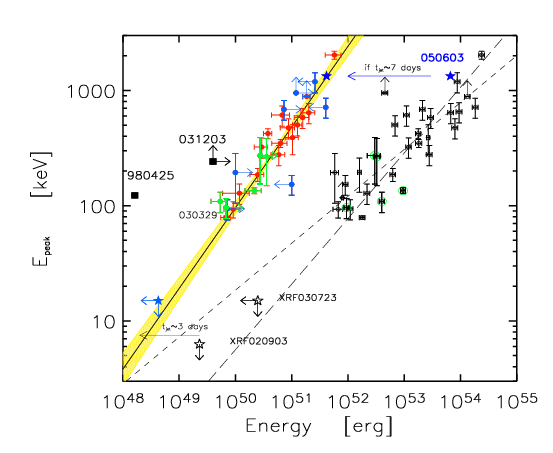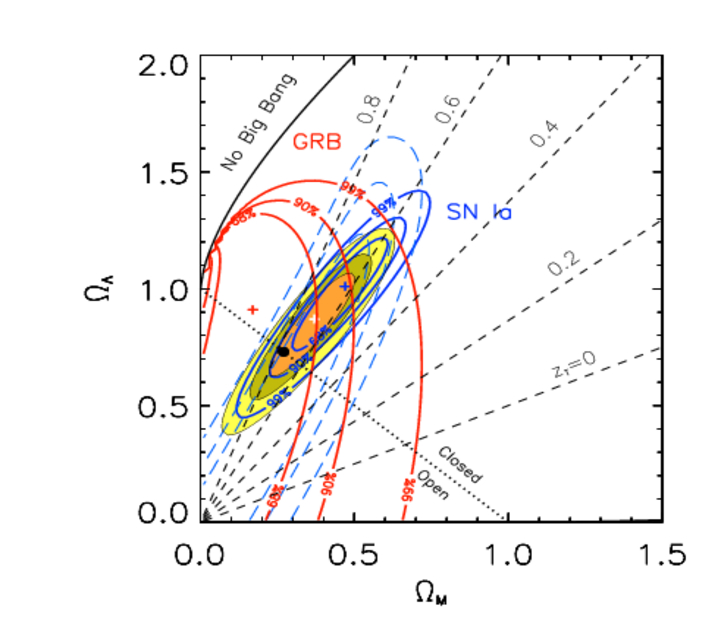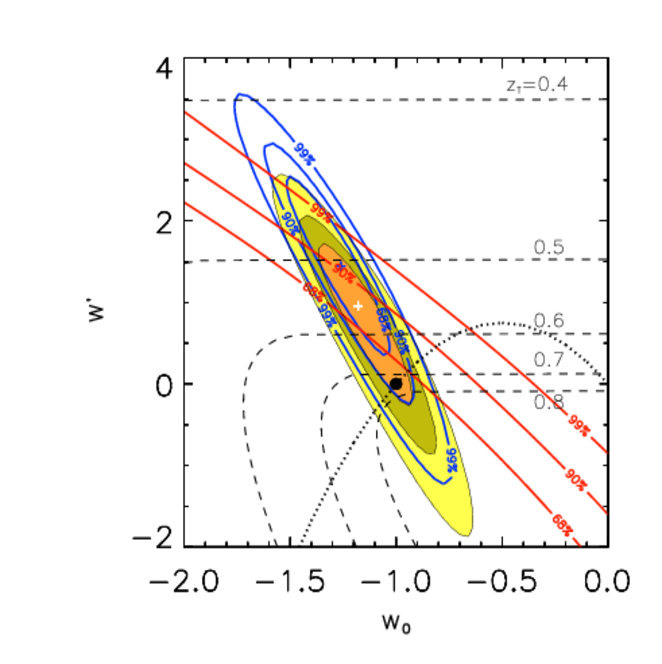
 |
GRB and COSMOLOGY |
|
Gamma Ray Bursts
are the most extreme extragalactic astrophysical sources: their
isotropic emitted energy is in the range 10^51 to 10^55 erg and they
are detected to very high redshift. Their high power makes them the
best candidate class of sources to probe the deep universe and its
evolution.
The large dispersion of the isotropic energy of GRBs is highly reduced if it is corrected for their collimation angles but it is still too large to make them standard candles. The discovery of
a correlation between the burst peak energy and their collimation
corrected energy allows instead to assign to each GRB its proper
energy. This correlation makes GRBs standard candles to be used
in observational cosmology similarly to SN Ia to test the cosmological
models. GRBs, being detected at larger redshift with respect to the
expected limit of SN Ia (i.e. z ~ 1.7), can probe the distant Universe
structure and dynamics.
The original sample of GRBs (15) which allowed to discover the E_gamma - E_iso correlation and to study for the first time the Universe with GRBs is continuously increasing. In this page we mantain an updated version of the correlation and of the constraints on the cosmological parameters by adding new GRBs. |
| Scope | Methods | Publications | People | Links |
|
Peak
Energy versus total energy updated [.ps image]
|
 |
| Black symbols (32 GRB + 2 XRF) represent the bolomentric isotropic energy (Eiso) of GRBs with measured reshift and prompt emission spectrum. | Red Symbols (15 GRBs) and green symbols (4 GRBs of the latest update) represent the bolometric collimation corrected energy (Eg) for those bursts with estimated jet break time. | Blue and green arrows (8 GRBs + 1 XRF and 2 GRBs of this update) represtent the upper/lower limits for Eg due to upper/lower limits on their jet break time |
| UPDATE | ||||||
| Redhisft |
Eiso
[erg] |
Ep*(1+z)
[keV] |
t_b [days] |
Angle [deg] |
Egamma [erg] |
|
| GRB 021004 |
2.33 | (3.3+-0.4)E52 |
266+-117 |
4.7+-0.5 |
8.5+-1.0 | (3.6+-0.9)E50 |
| GRB 030323 |
3.37 | (3.0+-0.8)E52 |
272+-118 |
> 4.8 |
> 7.8 |
> 2.8E50 |
| GRB 040924 |
0.859 | (9.5+-[1.0])E51 |
96+-[19] |
> 1.0 |
> 6.9 deg | > 6.8E49 |
| GRB 041006 |
0.716 | (4.0+-[0.4])E52 |
109+-[22] |
0.16+-0.04 | 2.98+-0.44 deg | (5.4+-1.7)E49 |
| GRB
050525 (*) |
0.606 | (9.6+-1.0)E52 |
135+-8 | 0.4+-0.1 | 3.86+-0.57
deg |
(2.18+-0.7)E50 |
|
Epeak
- Eiso Correlation
|
Rank corr. coeff. = 0.8571 Null
Hyp. prob. = 5.76e-09
[Epeak/100 keV] =
(3.0 +-1.0) [Eiso / 1.0E53]^(0.56+-0.02)
|
Chi2=7.4
(26 dof)
|
|
Epeak
- Egamma Correlation
|
Rank corr. coeff. = 0.9422 Null
Hyp. prob. = 2.92e-09
[Epeak/100 keV] = (3.0 +- 1.1) [Egamma
/
3.6E50]^(0.7+-0.04)
|
Chi2=1.33
(16 dof)
|
 |
 |
|
Constraints
on the cosmological parameters Omega matter
and Omega Lambda obtained with the sample of GRBs alone (red contours),
with the 156 SNIa (blue contours) and combining GRBs and SNIa (filled
region). The contraints of the CMB data
are also reported. Dashed lines correspond to the sign changing of the
cosmic acceleration at different redshifts.
[.ps image]
|
Constraints
on the parameters w0 and w´ of the
equation of state of the universe obtained with GRBs (red contours), SNIa (blue contours) and GRBs combined with SN Ia (filled regions). The balck point represents the standard cosmological constant model. The dotted line corresponds to the statefinder r=1. [.ps image] |